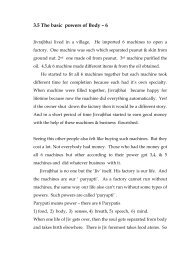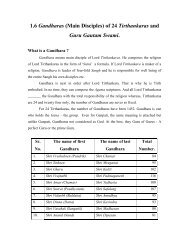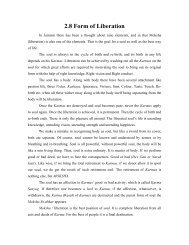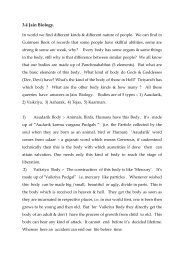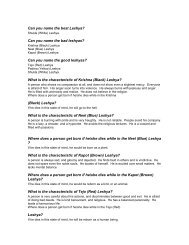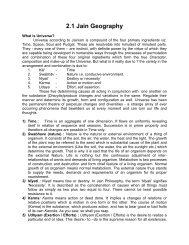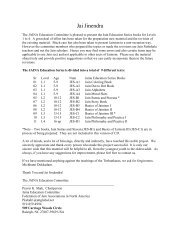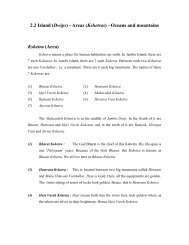âæ¢ ç¸ï¼¯ï¼ è£æ½® J - Jainism, Jain Religion - colleges
âæ¢ ç¸ï¼¯ï¼ è£æ½® J - Jainism, Jain Religion - colleges
âæ¢ ç¸ï¼¯ï¼ è£æ½® J - Jainism, Jain Religion - colleges
Create successful ePaper yourself
Turn your PDF publications into a flip-book with our unique Google optimized e-Paper software.
• As soon as the status of Tirthankar is attained Indra creates the divine pavilion (Samavasaran). In the assembly in this<br />
pavilion the Tirthankar gives discourses in the Ardha-Magadhi language with the view that the common man may be<br />
benefited. The Samavasaran is attended by all, including men, gods, and animals. In this first discourse at least one<br />
individual gets inspired to abandon mundane life and become an ascetic. Bhagavan sits in the lotus pose in the<br />
Samavasaran.<br />
• Tirthankar Munisuvrat and Arishtanemi were born in the Harivamsa clan and the remaining twenty-two in the Ikshvaku<br />
clan.<br />
• At the moment of their renunciation Bhagavan Rishabhdev was the oldest in age (8.4 million Purva). Bhagavan Parshvanath<br />
and Mahavir were the youngest in age (30 years).<br />
• The tallest among the Tirthankars was Bhagavan Rishabhdev (five hundred Dhanush) and the smallest was Bhagavan<br />
Mahavir (seven Haath/feet).<br />
„±üü ¿¢¢Ý¢² ½±¼é J<br />
age are the equal parts of average age of human beings of a specific era).<br />
• Vasupujya, Malli, Nami, Parshva and Vardhaman became ascetics as princes during the first third part of their life.<br />
Remaining nineteen Tirthankars became ascetics as kings during the last third part of their life. (The three divisions of<br />
• From Rishabh to Shreyans all Tirthankars not only did marry but ruled also, Vasupujya altered this tradition by becoming<br />
an ascetic when he was a young prince. The nineteenth and twenty-second Tirthankar remained unmarried.<br />
• Bhagavan Rishabh started the process of renunciation at Vinita town and Arishtanemi at Dwarka. All the remaining<br />
Tirthankars did at their respective birthplaces.<br />
• Bhagavan Mahavir was initiated alone, Parshvanath and Mallinath with three hundred persons each, Vasupujya with six<br />
hundred, Rishabh with four thousand and the remaining Tirthankars with one thousand persons each.<br />
• Tirthankar Shreyans, Malli, Munisuvrat, Arishtanemi and Parshva, all the five took Diksha during the forenoon and the<br />
remaining nineteen during the afternoon. Sumati took Diksha after having meals, Malli and Parshva after a three-day<br />
fast, Vasupujya after one day fast and the remaining Tirthankars after two-day fasts (on the last day of the fasting period).<br />
• Tirthankar Rishabh broke his fast after one year since the day of initiation, all the remaining Tirthankars the next day.<br />
• Tirthankar Rishabh got sugar cane juice as the first alms and the remaining ones got Ksheer (rice cooked in milk).<br />
• The places where the Tirthankars got their first alms were blessed with a shower of gold equivalent to the dimensions of<br />
their respective bodies.<br />
• All the Tirthankars of Bharat and Airavat areas except the first and the last propagate four-dimensional religion or the<br />
religion with four great vows as its central theme. The four vows are-abandonment of or refraining from-1. all types of<br />
violence, 2. all types of falsity, 3. all types of unoffered acquisition, and 4. all types of possessions. The first and the last<br />
Tirthankars propagate five dimensional religions by adding the vow of abandonment of all types of lustful activities to the<br />
above four.<br />
jainuniversity.org<br />
• The Ashok tree under which Mahavir got initiated was of 32 Dhanush height. The Chaitya tree of Rishabhdev of height<br />
equipment to three times that of his body. All the remaining Tirthankars were initiated under trees having height equivalent<br />
to 12 times the height of their respective bodies.<br />
• Bhagavan Rishabh attained omniscience after a thousand years of his initiation and Mallinath just after four and halfhours.<br />
• The area of the divine pavilion of Rishabh was 12 Yojans. There was a gradual reduction of 2 Kosa (1/2 Yojan) in this area<br />
for succeeding Tirthankars till Naminath (22 nd ). The area of the divine pavilion of the twenty third Tirthankar, Parshvanath<br />
was 1-5 Yojans and that of Mahavir was one Yojan. These dimensions are for the descending cycle that for the ascending<br />
cycle is the same but in reverse order. In the Videh area the dimension is 12 Yojans uniformly. Indranilmani (Sapphire)<br />
is essentially used in the decoration of these Samavasarans.<br />
• The maximum number of chief disciples was one hundred for Bhagavan Sumatinath and the minimum for Parshvanathten.<br />
• When the Karmic ties are completely broken the Tirthankar stops the speech completely.<br />
• Before the Nirvana (liberation) Rishabhdev had observed a last penance (Santhara) of six days, Mahavir that of two days,<br />
and the remaining Tirthankars that of one month.<br />
• Rishabh, Arishtanemi and Mahavir, all these three were sitting in the Paryankasana (a specific yogic posture) and the<br />
remaining twenty one were standing in the Kayotsarga Mundra (a yogic posture) at the moment of liberation.<br />
• Rishabhdev was liberated at the Ashtapad Mountain, Arishtanemi at Girnar Mountain, Vasupujya at Champa town, Mahavir<br />
at Pava town and all the rest at Sammetshikhar (Parasnath hills).<br />
Amar Muni - Tirthankar Charitra - Surana # 48<br />
www.jainuniversity.org




